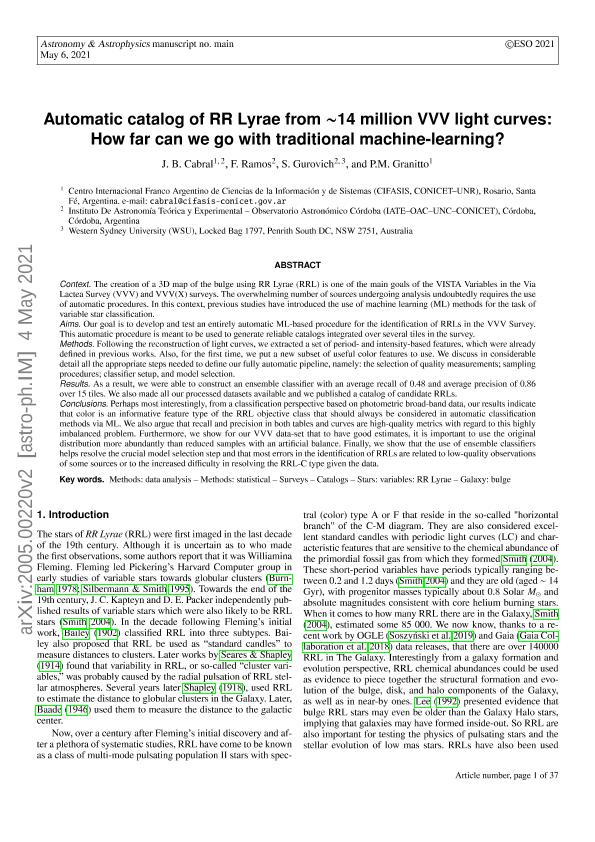Artículo
Automatic catalog of RR Lyrae from ∼14 million VVV light curves: How far can we go with traditional machine-learning?
Cabral, Juan Bautista ; Ramos Almendares, Felipe Alberto
; Ramos Almendares, Felipe Alberto ; Gurovich, Sebastian
; Gurovich, Sebastian ; Granitto, Pablo Miguel
; Granitto, Pablo Miguel
 ; Ramos Almendares, Felipe Alberto
; Ramos Almendares, Felipe Alberto ; Gurovich, Sebastian
; Gurovich, Sebastian ; Granitto, Pablo Miguel
; Granitto, Pablo Miguel
Fecha de publicación:
10/2020
Editorial:
EDP Sciences
Revista:
Astronomy and Astrophysics
ISSN:
0004-6361
Idioma:
Inglés
Tipo de recurso:
Artículo publicado
Clasificación temática:
Resumen
Context. The creation of a 3D map of the bulge using RR Lyrae (RRL) is one of the main goals of the VISTA Variables in the Via Lactea Survey (VVV) and VVV(X) surveys. The overwhelming number of sources undergoing analysis undoubtedly requires the use of automatic procedures. In this context, previous studies have introduced the use of machine learning (ML) methods for the task of variable star classification. Aims. Our goal is to develop and test an entirely automatic ML-based procedure for the identification of RRLs in the VVV Survey. This automatic procedure is meant to be used to generate reliable catalogs integrated over several tiles in the survey. Methods. Following the reconstruction of light curves, we extracted a set of period- and intensity-based features, which were already defined in previous works. Also, for the first time, we put a new subset of useful color features to use. We discuss in considerable detail all the appropriate steps needed to define our fully automatic pipeline, namely: the selection of quality measurements; sampling procedures; classifier setup, and model selection. Results. As a result, we were able to construct an ensemble classifier with an average recall of 0.48 and average precision of 0.86 over 15 tiles. We also made all our processed datasets available and we published a catalog of candidate RRLs. Conclusions. Perhaps most interestingly, from a classification perspective based on photometric broad-band data, our results indicate that color is an informative feature type of the RRL objective class that should always be considered in automatic classification methods via ML. We also argue that recall and precision in both tables and curves are high-quality metrics with regard to this highly imbalanced problem. Furthermore, we show for our VVV data-set that to have good estimates, it is important to use the original distribution more abundantly than reduced samples with an artificial balance. Finally, we show that the use of ensemble classifiers helps resolve the crucial model selection step and that most errors in the identification of RRLs are related to low-quality observations of some sources or to the increased difficulty in resolving the RRL-C type given the data.
Archivos asociados
Licencia
Identificadores
Colecciones
Articulos(CIFASIS)
Articulos de CENTRO INT.FRANCO ARG.D/CS D/L/INF.Y SISTEM.
Articulos de CENTRO INT.FRANCO ARG.D/CS D/L/INF.Y SISTEM.
Articulos(IATE)
Articulos de INST.DE ASTRONOMIA TEORICA Y EXPERIMENTAL
Articulos de INST.DE ASTRONOMIA TEORICA Y EXPERIMENTAL
Citación
Cabral, Juan Bautista; Ramos Almendares, Felipe Alberto; Gurovich, Sebastian; Granitto, Pablo Miguel; Automatic catalog of RR Lyrae from ∼14 million VVV light curves: How far can we go with traditional machine-learning?; EDP Sciences; Astronomy and Astrophysics; 642; 10-2020; 1-38
Compartir
Altmétricas



